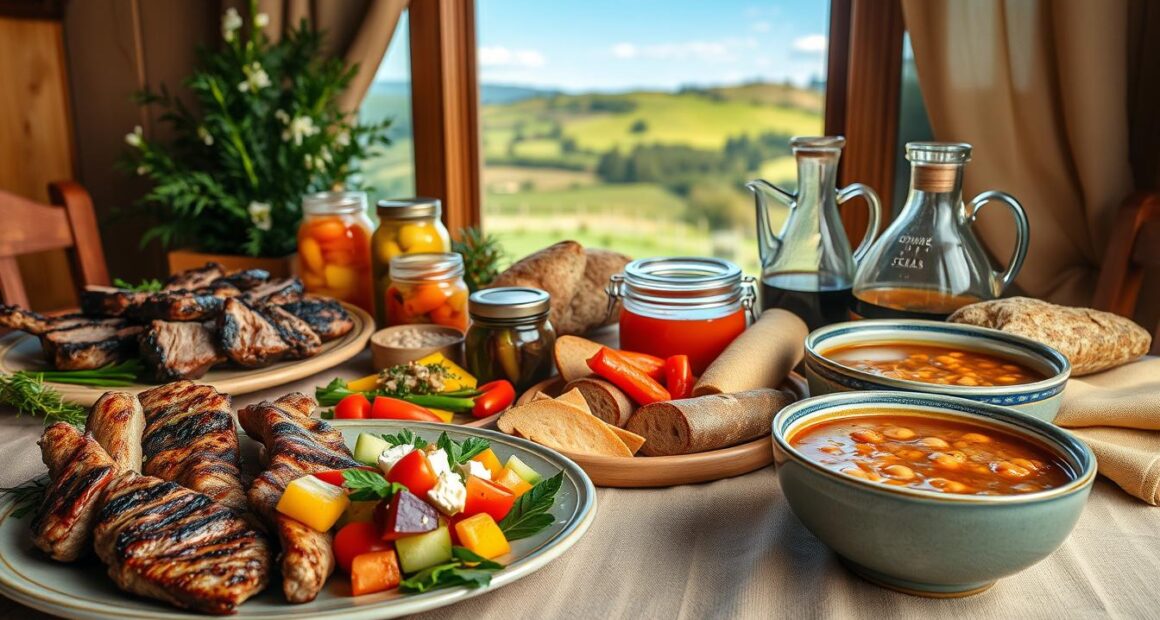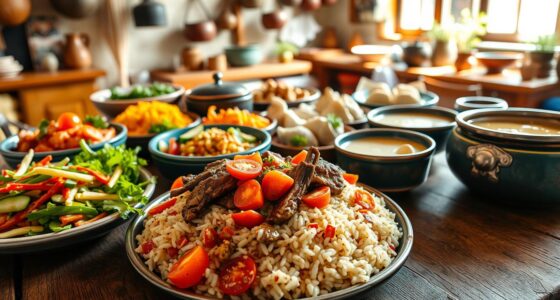Imagine walking through a vibrant market, the air filled with the unmistakable aromas of sizzling meats and freshly baked pastries. This is the heartbeat of Bulgarian cuisine, where every bite tells a story of rich traditions and cultural heritage. As you take the time to savor these indulgent flavors, you can’t help but feel a deep connection to the land and people who created them. From the flaky layers of Banitsa enjoyed at breakfast to the comforting warmth of a homemade Moussaka, authentic Bulgarian cuisine invites you to explore Bulgarian food culture in all its glorious diversity. So, roll up your sleeves and prepare to embark on a culinary journey, one that will undoubtedly leave your taste buds dancing and your heart full.
Key Takeaways
- Bulgarian cuisine is known for its rich flavors and diverse influences from the Balkans and Mediterranean.
- Staple dishes like Banitsa and Moussaka reflect the culinary traditions cherished by locals.
- Over 70% of Bulgarians eat Kebapche, highlighting its popularity as street food.
- The fresh ingredients used in dishes like Shopska Salad and Tarator showcase the importance of local produce in Bulgarian cuisine.
- Bulgarian yogurt is renowned globally, known for its health benefits and probiotic properties.
Introduction to Bulgarian Cuisine
Bulgarian cuisine reflects the heart of its vibrant culture, merging rich Mediterranean and Balkan flavors. A significant aspect of this culinary tradition lies in its emphasis on fresh, local ingredients, where vegetables, dairy, and meats take center stage. This unique blend highlights the diversity of Bulgarian gastronomy, which celebrates the past while embracing modern culinary practices.
A Unique Blend of Flavors
Every dish tells a story. The use of ingredients like yogurt and sirene cheese showcases Bulgaria’s recognition as a world leader in dairy products, particularly because of the Lactobacillus bulgaricus strain, which is essential for local yogurt. This has led to a higher per-capita yogurt consumption in Bulgaria than in other European countries. Traditional foods such as pastries, soups, and salads are pivotal in daily life, while special dishes are often prepared for holidays, such as vegetarian stuffed peppers on Christmas Eve.
Cultural Influences on the Cuisine
Cultural influences in Bulgarian cuisine weave a narrative shaped by history. The cuisine manifests characteristics shared with other Balkan cuisines, absorbing elements from Ottoman and Middle Eastern traditions. Grilling remains a favored cooking technique, showcasing flavorful sausages like kebapche and kyufte. This blend of flavors and techniques provides a culinary experience that transports you through time, making each meal an exploration of Bulgaria’s rich heritage.
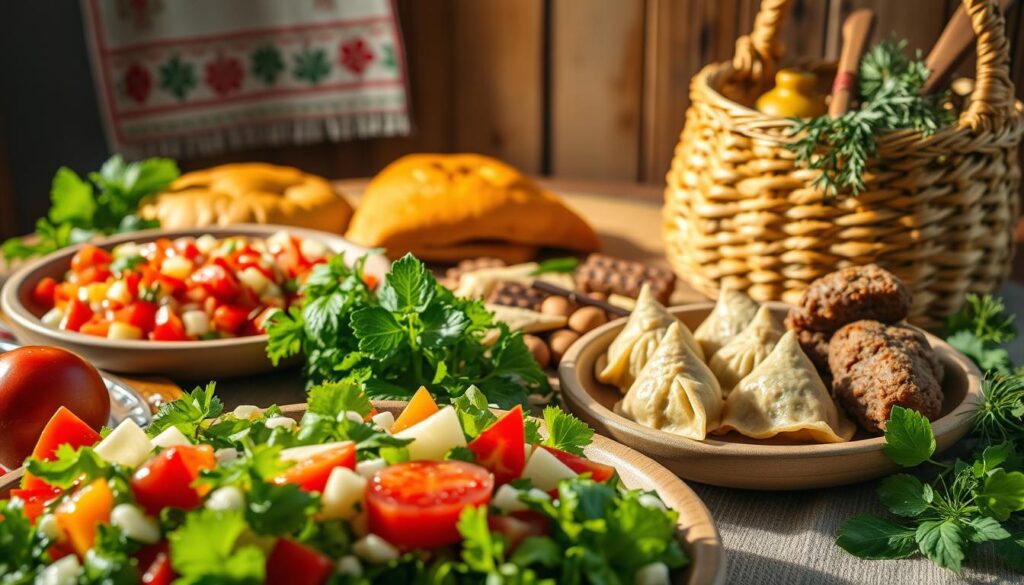
Traditional Bulgarian Ingredients
Understanding the core of Bulgarian cuisine reveals a focus on fresh, high-quality components. Traditional Bulgarian ingredients play a vital role in crafting dishes that are both flavorful and nostalgic. Fresh vegetables in Bulgarian cuisine take center stage, highlighting the freshness and vibrancy typical of the region’s produce.
Fresh Vegetables and Herbs
Fresh vegetables in Bulgarian cuisine are essential for creating delicious, hearty meals. Tomatoes, cucumbers, and peppers are staples, often featured in salads and side dishes. One of the most beloved dishes, Shopska salad, showcases these fresh ingredients with chopped tomatoes, cucumbers, bell peppers, and crumbled feta cheese.
- Tomatoes: Bright and juicy, they contribute a refreshing flavor to many dishes.
- Cucumbers: Crunchy and hydrating, perfect for cooling summer salads.
- Peppers: Both sweet and spicy varieties are used to add depth to recipes.
Herbs such as dill and parsley enhance the flavors in traditional meals, making them aromatic and unique. These fresh herbs are frequently used in soups and salads, enriching the culinary experience.
Dairy Products and Their Importance
Dairy products hold a special place in Bulgarian cuisine, with yogurt being a cultural staple. Made from locally sourced milk and the famous Lactobacillus bulgaricus bacteria, Bulgarian yogurt is renowned for its rich flavor and creamy texture. It often serves as a base for cold soups like tarator, which combines yogurt with fresh cucumbers, garlic, walnuts, and olive oil.
Another key dairy ingredient is sirene, a salty white cheese used liberally in salads and pastries like banitsa. This feta-style cheese not only enhances the taste of various dishes but also reflects the significance of dairy farming in Bulgaria.
The combination of fresh vegetables and essential dairy products outlines the foundation of traditional Bulgarian ingredients, creating a rich tapestry of flavors that continue to delight palates around the world.
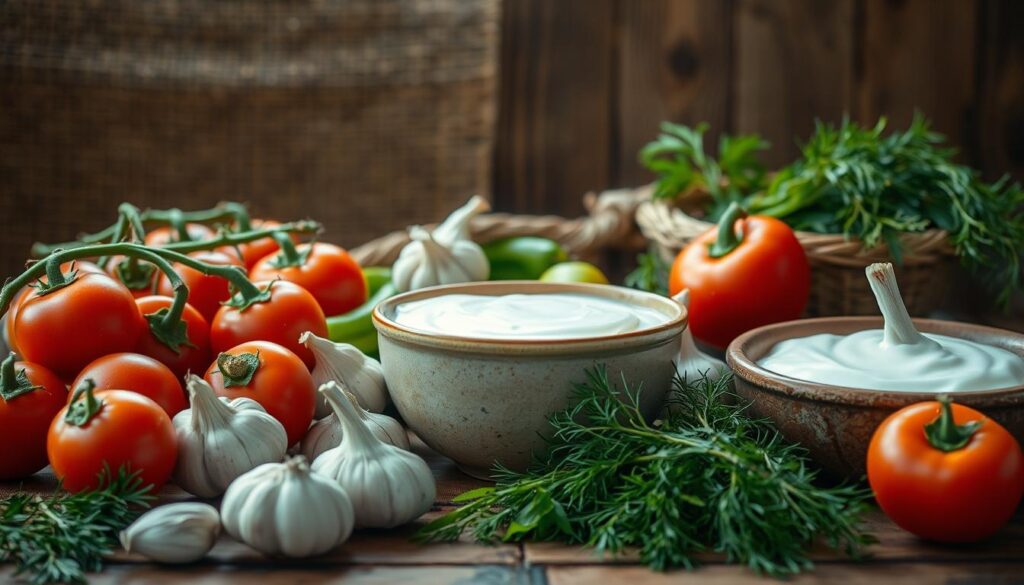
Popular Bulgarian Dishes
Explore the diverse flavors that make Bulgarian cuisine so captivating. The best Bulgarian dishes demonstrate a harmonious blend of fresh ingredients, traditional recipes, and regional influences. Many of these dishes are staples in Bulgarian households, reflecting the country’s rich culinary heritage.
Banitsa: A Must-Try Pastry
Banitsa stands out as one of the most addictive breakfast options among popular Bulgarian foods. This pastry consists of layers of filo dough filled with a mix of beaten eggs and cheese, baked until golden and crisp. Often enjoyed in the morning, banitsa is a delightful start to your day and can be found in bakeries throughout Bulgaria.
Shopska Salad: A Fresh Delight
Shopska salad is a quintessential dish that showcases the country’s emphasis on fresh vegetables. Made with diced tomatoes, cucumbers, and bell peppers, this salad is topped with crumbly Bulgarian cheese, making it incredibly refreshing. It is often considered the most popular salad in Bulgaria and is enjoyed year-round, embodying the essence of local produce.
Kavarma: A Hearty Meat Stew
Kavarma is a hearty meat stew, reflecting the robust flavors characteristic of Bulgarian cuisine. Slow-cooked with an array of vegetables, it maximizes tenderness and richness, showcasing the culinary traditions passed down through generations. This dish truly highlights why Balkan foods are beloved during family meals and gatherings.
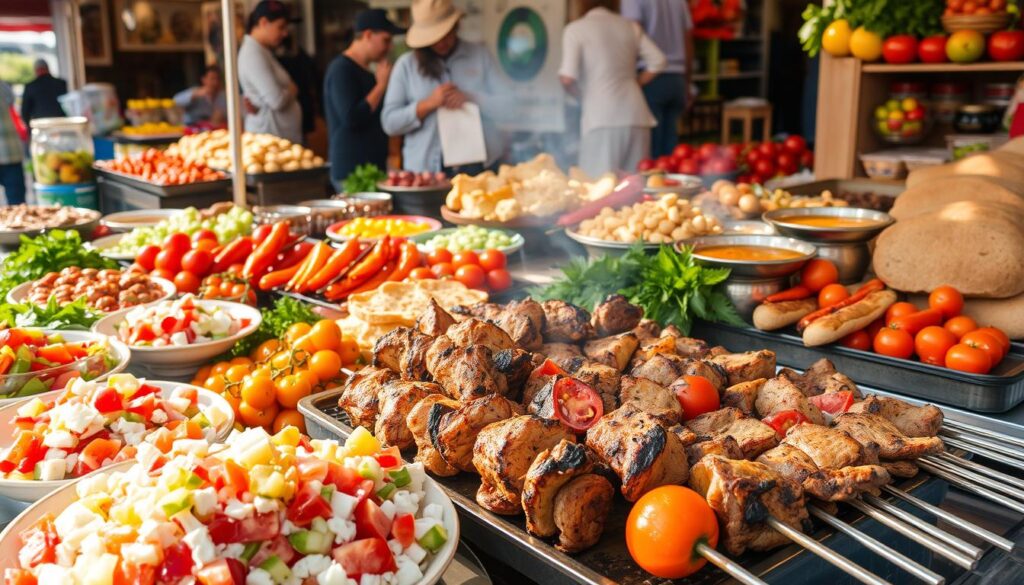
Bulgarian Meze: Small Plates to Share
Exploring the concept of bulgarian meze opens a window into the social and communal aspects of dining in Bulgaria. These enticing small plates in bulgarian cuisine are perfect for sharing, making any meal an opportunity for friends and family to gather around the table. This tradition fosters a sense of togetherness, allowing everyone to sample a variety of flavors and textures.
The Joy of Tapas-Style Eating
Embracing the tapas-style eating experience, you will find that bulgarian meze encourages a relaxed and sociable atmosphere. Diners can enjoy a selection of appetizers that not only stimulate the appetite but also promote conversation and laughter. These small plates are often paired with drinks as well, making them an essential part of any gathering or celebration.
Examples of Popular Meze
- Lukanka: A spicy cured sausage, enjoyed by many and often featured on charcuterie boards.
- Shopska salad: A refreshing mix of tomatoes, cucumbers, peppers, and brined cheese, a staple in many restaurants.
- Lyutenitsa: A spicy pepper and tomato relish, a widely used condiment that enhances many dishes.
- Kyufte: Flavorful grilled meatballs that are well-loved and commonly served.
- Karnache: A traditional sausage served in various settings, gatherings frequently showcase this dish.
- Tarator: A cold yogurt soup that cools down summer meals, enjoyed by many locals.
- Chushki Burek: Bell peppers stuffed with cheese, this dish adds a delightful flavor to any meze platter.

The Role of Bread in Bulgarian Meals
Bread plays a vital role in your Bulgarian culinary experience. Often viewed as a symbol of hospitality, family, and home, traditional bread in Bulgarian cuisine is a staple at every meal. This cultural significance is highlighted by the presence of bread during holidays and everyday meals alike. The most common types, including small flat loaves, are found on the dining table of Bulgarian families, embodying their rich culinary heritage.
Types of Bulgarian Bread
Bulgarian bread varieties are diverse and often tied to specific celebrations or daily life. Here are some popular types:
- Pita Bread: A versatile flatbread enjoyed with main dishes.
- Kozunak: A sweet, braided bread typically prepared for Easter.
- Hlebar: The standard small flat loaf commonly found on family tables every day.
Each type of bread carries its own story, reflecting the traditions and customs of the locale. The daily consumption of bread often includes pairings with cheese, savory spreads, or honey, heightening the flavors during meals.
Making Your Own: Tips and Tricks
Creating authentic bread at home can connect you more deeply with traditional bread in Bulgarian cuisine. To make a standard small flat loaf, begin with:
| Ingredient | Quantity |
|---|---|
| Fine white flour | 500 g |
| Warm water | 160-180 ml |
| Eggs | 3 |
| Fat (butter or other) | 100 g |
| Sugar | A pinch |
The process involves kneading the dough until it reaches a moderately soft and elastic consistency. Allow it to rise until it doubles in size, which is a key sign of fermentation. After baking, serve your fresh bread with favorite condiments or with a side of luk, bread and onion, to truly savor Bulgarian tradition.

Desserts You’ll Love
Bulgaria boasts a wide array of delectable desserts that provide a delightful conclusion to any meal. You will find that many of these bulgarian desserts carry deep cultural significance and reflect the nation’s passion for sweets. Traditional bulgarian sweets often encompass an array of tastes and textures, making them a treat worth exploring.
Baklava: A Sweet Indulgence
Baklava, though often linked with Turkish cuisine, holds a cherished spot among Bulgarian desserts. This exquisite treat features layers of filo pastry, generously filled with nuts and sweetened with honey or syrup. It is a staple during special occasions, including the festive celebrations of Christmas and New Year, ensuring its place in your dessert repertoire.
Torta Ruska: A Chocolate Delight
If you’re a fan of chocolate, Torta Ruska is not to be missed. This decadent Bulgarian cake consists of rich chocolate layers paired with a unique cream filling, providing a luxurious experience for your taste buds. It’s a favorite for birthdays and celebrations, making it a delightful addition to any gathering.

- Mekitsi: Popular breakfast items that are often prepared overnight.
- Marudnik: A traditional pancake topped with jam and powdered sugar.
- Künefe: A sweet cheese pastry that is easy to prepare.
- Tulumbichki: Fried dough pastries, known for their crowd-pleasing nature.
- Garash: A beloved chocolate cake that appeals to all ages.
- Kifla: Sweet crescents filled with delightful jam or cream.
Exploring the world of bulgarian desserts can enhance your appreciation for authentic cuisine. Each sweet treat tells a story of cultural heritage, inviting you to indulge in the rich flavors and traditions that Bulgaria has to offer.
Beverages of Bulgaria
Exploring the world of Bulgarian beverages offers a wonderful glimpse into the rich culinary heritage of the country. From its exceptional wines to the distinctive spirit of rakiya, drinking in Bulgaria is a sensory experience reflective of the nation’s culture and traditions. You’ll find that both traditional bulgarian drinks and unique local offerings paint a vivid picture of Bulgaria’s identity.
Traditional Bulgarian Wines
The Bulgarian wine industry has flourished for thousands of years, showcasing a variety of grapes such as Mavrud, Plavac Mali, and Vranec. Each region contributes a unique character to its wines, particularly the Melnik Region, known for its exquisite varietals. Wine enthusiasts will revel in the bold flavors that complement the hearty dishes typical in Bulgarian cuisine. Bulgaria stands among the world’s top wine exporters, emphasizing its significant role in the global market. Sampling these bulgarian beverages provides an authentic cultural experience.
Rakiya: The Spirit of Bulgaria
No discussion of traditional bulgarian drinks would be complete without mentioning rakiya, the country’s iconic fruit brandy. With an alcohol content ranging from 40% to 50%, this spirit is often enjoyed as an appetizer or during festive gatherings. Homemade rakiya frequently boasts even higher alcohol percentages than store-bought varieties, making it a cherished beverage among locals. Rakiya’s presence at any Bulgarian meal symbolizes hospitality and celebration, further intertwining it with the rich tapestry of Bulgarian culinary traditions.

The Importance of Festivals in Cuisine
Festivals play a vital role in the rich tapestry of bulgarian food culture, elevating traditional dishes to center stage and celebrating communal bonds. During these festive occasions, food takes on new significance, weaving stories of heritage and uniting people in joyful gatherings. From the hearty flavors of locally sourced ingredients to recipes for festival foods, these events showcase the culinary diversity found across Bulgaria. Experience the festivity where each meal represents not just sustenance but also a shared history and cultural pride.
How Food Celebrates Heritage
Bulgarian festivals often embody a deep connection to the land and tradition, with food serving as a focal point of celebration. Events like the International Folklore Festival in Burgas highlight the lively atmosphere, where traditional meals provide a sensory experience that transports attendees into a world of customs and history. With a largely homogeneous population, regional variations in celebrations are minimal, yet each festival uniquely reflects the country’s rich cultural fabric.
Recipes for Festival Favorites
Bringing festival favorites home can be a delightful way to explore bulgarian food culture. Consider trying out popular recipes that resonate with the spirit of these celebrations. Some delightful options to consider include:
- Stuffed Peppers: A hearty dish symbolizing abundance, often filled with a mix of rice and minced meat.
- Homemade Bread: Essential to any Bulgarian meal, special breads are often baked for occasions, showcasing elaborate shapes and flavors.
- Patatnik: A traditional dish from the Rhodope Mountains, combining potatoes and cheese, perfect for sharing.
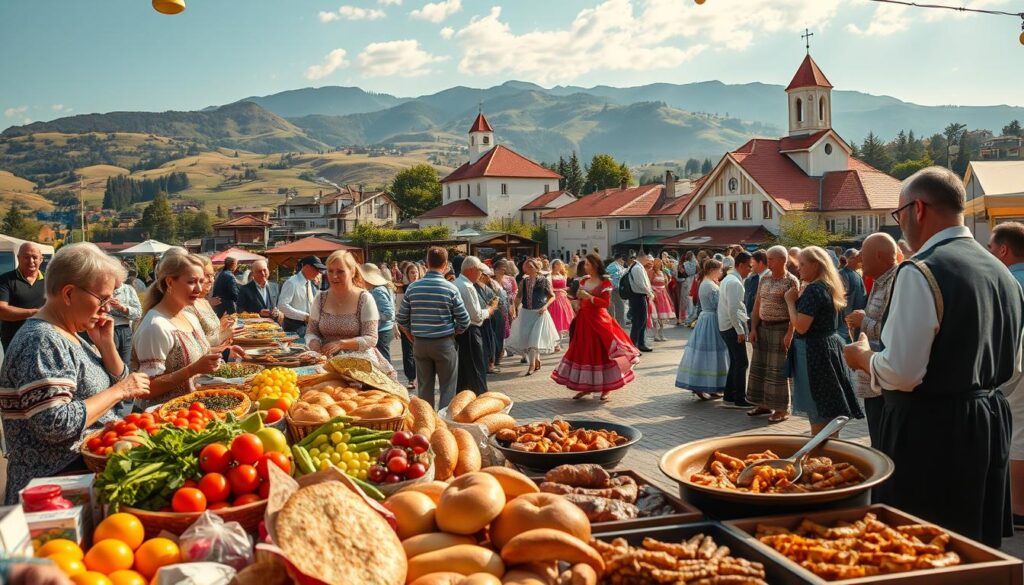
As you dive into these recipes for festival foods, celebrate the rich heritage each dish represents while creating memories reminiscent of Bulgaria’s vibrant festivals. Embrace the joy of cooking and savor the connections made through these delightful culinary traditions.
Impressive Cooking Techniques
When diving into cooking techniques in bulgarian cuisine, you’ll discover a rich tapestry of methods that bring out the best flavors in traditional dishes. Those methods enhance both the natural tastes of ingredients and the culinary experience as a whole. Highlighted below, grilling and roasting stand out, especially for meats and vegetables, while pickling plays a pivotal role in preserving seasonal bounty.
Grilling and Roasting: A Bulgarians Skill
Bulgarians have mastered the art of grilling and roasting, creating mouthwatering dishes that are at the heart of social gatherings. The traditional mixed grill, known as meshana skara, features an assortment of sausages and minced meat products that showcase flavors unique to the region. Grilled meats, particularly pork, chicken, and lamb, are staples at many meals, often enjoyed with a side of fresh salads or warm bread.
Pickling and Preserving for Flavor
Pickling is a cherished technique within traditional methods of cooking in Bulgaria. Seasonal vegetables are transformed into delightful pickled treats that not only preserve their taste but also provide vibrant flavors throughout the year. Carrots, cucumbers, and peppers find their way into jars, ensuring that these seasonal delights can be enjoyed well beyond their harvest. This practice reflects the strong agricultural traditions in Bulgaria, emphasizing the connection between cooking and local produce.

Vegetarian and Vegan Options
Bulgarian cuisine offers a variety of delightful vegetarian bulgarian dishes, showcasing the appeal of fresh vegetables, grains, and legumes. Although Bulgaria is known for its hearty meat dishes, you will discover many enticing plant-based options at local restaurants and cafes.
Delicious Plant-Based Dishes
Among the standout choices are:
- Shopska Salad: This refreshing blend of chopped tomatoes, cucumbers, olives, and the signature local cheese, sirene, provides a vibrant taste experience.
- Monks Salad: Featuring strained yogurt, cheese, roasted peppers, and garlic, this dish offers a blend of flavors, perfect for those looking for lighter fare.
- Tarator Soup: This cold soup made from yogurt, cucumbers, and dill may challenge your expectations of traditional soups while being a refreshing choice during warmer months.
- Stuffed Peppers: Often filled with rice and herbs, these peppers can be prepared without meat, giving you a satisfying vegetarian option.
- Lyutenitsa: This popular spread made from tomatoes and eggplant can add a flavorful dimension to your bread or wraps.
Exploring Traditional Techniques
Bulgarian culinary traditions highlight unique cooking methods that enhance the natural flavors of vegetables. Techniques like grilling and roasting create delightful textures and aromas that elevate vegetarian bulgarian dishes. For vegans, many of these cooking methods eliminate the need for animal products, allowing you to fully embrace vegan options in bulgarian cuisine.
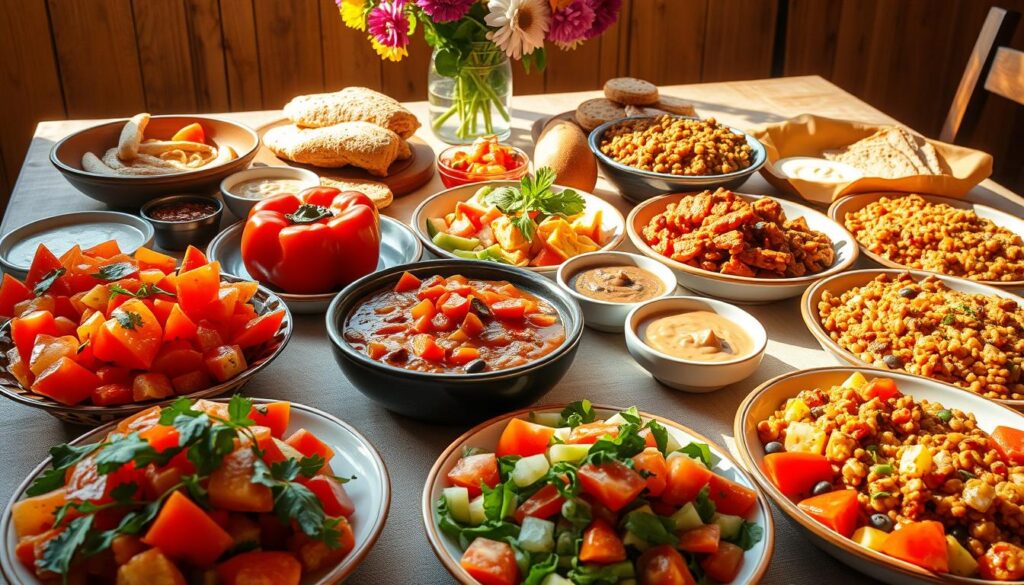
Dining Etiquette in Bulgaria
Understanding the meal etiquette in Bulgaria offers insight into the rich dining customs in bulgarian culture. Meals are more than just sustenance; they represent an opportunity for connection and hospitality. Recognizing local practices enhances your dining experience and demonstrates respect for traditions.
How to Enjoy a Meal Like a Local
When dining in Bulgaria, believe in the significance of waiting for the host to begin the meal. This custom shows respect and acknowledges the role of the host. An important aspect is the art of offering toasts. It’s common to toast with rakiya before starting, making it a celebratory initiation to your meal.
Customary Practices at the Table
Notably, Bulgarians serve food in portions that allow for second helpings, reflecting a culture of generosity. The eldest person at the table is served first, underscoring the importance of age and position in dining etiquette in bulgaria. Bringing a small gift when invited to someone’s home, such as a bottle of wine or flowers, is customary, reinforcing the communal spirit cherished in Bulgarian meals.
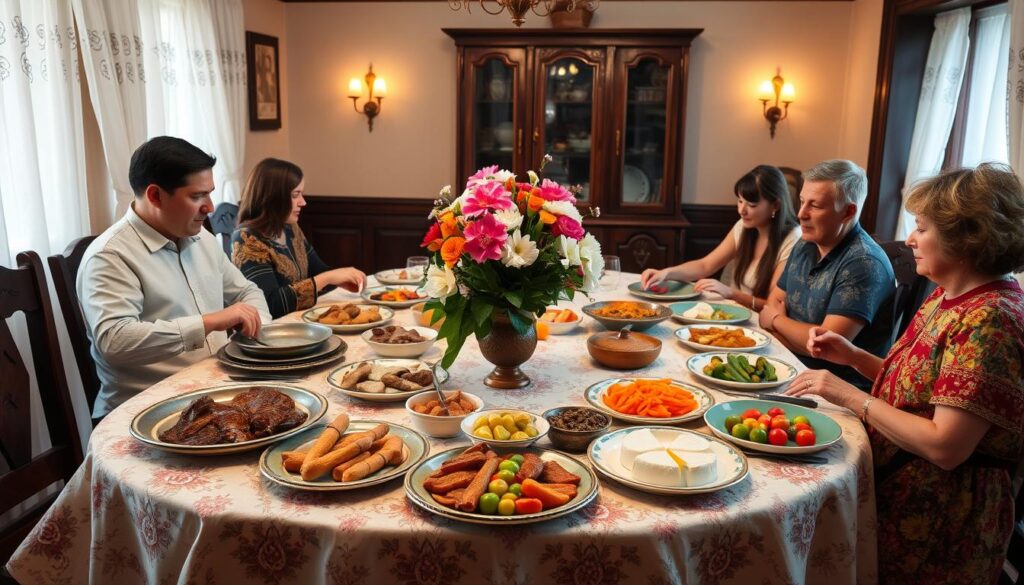
Influence of Seasons on Cuisine
Bulgarian cuisine beautifully reflects seasonal changes, showcasing a variety of ingredients that shift with the time of year. Understanding these seasonal changes in bulgarian cuisine enhances your appreciation for the flavors and dishes that define this rich culinary tradition. Each season brings its own bounty, allowing chefs and home cooks alike to create dishes that highlight the freshest ingredients available.
Seasonal Ingredients You Should Know
In Bulgaria, the produce available changes throughout the year, impacting everything from salads to hearty soups. Spring introduces vibrant greens and a variety of herbs, while summer brings fresh fruits like figs and berries. As autumn arrives, markets overflow with colorful peppers, squash, and root vegetables, perfect for warming dishes and stews. Winter markets continue to offer ingredients like preserved vegetables that echo the flavors of the harvest days in bulgaria. Understanding these seasonal ingredients allows you to enjoy dishes at their peak flavor and freshness.
Celebrating Harvest Days
Harvest days in bulgaria are a time for communities to come together and celebrate the fruits of their labor. These occasions often include traditional foods, emphasizing the connection between the land and its bounty. Popular dishes made during these celebrations might feature roasted vegetables, homemade breads, and dairy products, all showcasing seasonal ingredients. Participating in these harvest events provides a deeper insight into the culinary heritage of Bulgaria and the significance of seasonal changes in bulgarian cuisine.

Bulgarian Cuisine Around the World
Bulgarian cuisine has captured hearts and palates across various continents, reflecting its rich flavors and diverse influences. The global influence of Bulgarian cuisine is evident as traditional dishes make their way into menus worldwide, especially in the United States. This culinary journey showcases not only the unique flavors but also the traditions behind these beloved recipes.
How Bulgarian Food has Globalized
Over the years, Bulgarian food has been embraced by many countries, contributing to its growing popularity. Classic dishes such as Banitsa, a delightful pastry made with eggs and white cheese, have become favorites even outside Bulgaria. Elements like the refreshing Shopska salad or the hearty Kavarma stew highlight how Bulgarian flavors resonate with diners looking for something unique.
Notable Bulgarian Restaurants in the US
You can find a variety of Bulgarian restaurants in the US that celebrate these dishes. Some notable establishments include:
- Restaurant Vitosha – Known for its traditional ambiance and authentic recipes, this place offers a menu that includes everything from Tarator to Meshana Skara.
- Bulgarian Grill – Famous for its grilled meats, this restaurant specializes in Kebapche and Kyufte, showcasing the robust flavors of Bulgarian cuisine.
- Little Bulgaria – A cozy spot that presents a wide range of Bulgarian dishes, including Sirene salad and Shkembe Chorba, inviting diners to experience comfort food from Bulgaria.
These Bulgarian restaurants in the US serve as cultural ambassadors, introducing people to the essence of Bulgaria, one meal at a time. Visitors often leave not just satisfied but with a newfound appreciation for the global appeal of Bulgarian food.
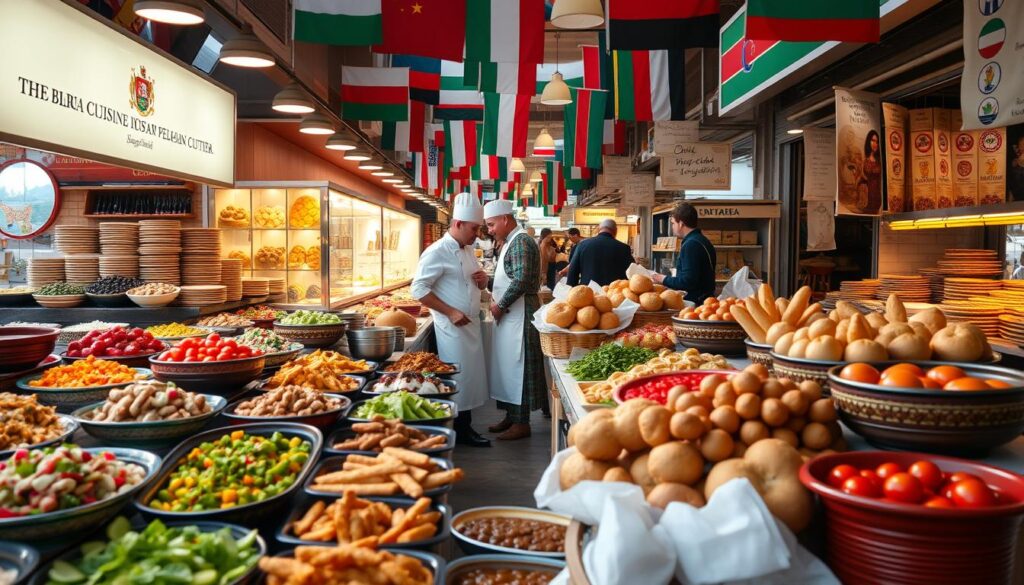
Recipes to Get You Started
Venturing into the realm of Bulgarian cuisine can be exciting and rewarding. With a plethora of bulgarian recipes for beginners, you’ll find joy in crafting traditional dishes rich in flavor and culture. Simple recipes provide an excellent starting point for home cooks eager to embrace this culinary heritage. Whether you aim to make a vibrant salad or a comforting main course, these suggestions and cooking tips for bulgarian cuisine will help you navigate your cooking journey.
Simple Bulgarian Recipes for Home Cooks
- Shopska Salad: This refreshing salad features 4 medium tomatoes, 1/2 cucumber, and 4 spring onions. Ideal for 4-5 servings, it’s a perfect beginner dish.
- Snezhanka Dip: An easy yogurt dip requiring 500g of yogurt, serving 2-3 people, pairs wonderfully with fresh bread.
- Spinach Soup: Simple in preparation, this soup takes about 15-20 minutes to boil and an additional 5-10 minutes to simmer, perfect for a beginner.
- Gyuveche: This hearty dish combines ground beef, potatoes, and eggs, with a total preparation time of 55 minutes. It serves 8, making it great for gatherings.
Tips for Flavorful Cooking at Home
Incorporating authentic flavors into your dishes enhances the overall experience. Here are some essential cooking tips for bulgarian cuisine:
- Use fresh ingredients, as the quality of your produce can elevate your dishes significantly.
- Experiment with traditional spices like paprika and dill for an authentic taste.
- Pay attention to cooking times; many Bulgarian recipes, such as braised beef or pork, benefit from dedicated cooking of about 30 minutes after initial preparation.
- Consider portion sizes in your recipes, such as using 2-3 aubergines for starters to serve 4 people effectively.

Dive into Bulgarian cooking with these straightforward recipes and invaluable tips, and soon you’ll find yourself crafting delightful meals that impress family and friends alike.
Final Thoughts on Bulgarian Cuisine
Exploring Bulgarian cuisine is not just about tasting new dishes; it’s an invitation to embrace new tastes and immerse yourself in a rich cultural tapestry. Each meal serves as a portal to Bulgaria’s heritage, revealing stories woven through generations. From the fresh, organic produce found in local gardens to the flavourful dishes like Shopska Salad and the iconic Sirene cheese, every bite allows you to discover Bulgarian flavors and connect with the traditions that shape this culinary landscape.
Embracing New Tastes
By choosing to explore traditional Bulgarian cuisine, you venture into a world that celebrates the art of sharing and community. The vibrant markets offer an abundance of ingredients, such as homemade jams and locally sourced Rakia, elevating your dining experience. Understanding the significance of dishes like Kebapche and the beloved Kiselo Mlyako not only enriches your palate but also fosters an appreciation for the local practices and values embedded in culinary customs.
Encouragement to Explore More
Your journey into Bulgarian cuisine shouldn’t end here. Let the desire to discover Bulgarian flavors guide your culinary adventures—try your hand at cooking traditional recipes at home, or visit local Bulgarian eateries to experience the authentic flavors firsthand. Every meal, whether enjoyed at home or in a restaurant, is an opportunity to delve deeper into Bulgaria’s delightful food scene, expanding your culinary repertoire while savoring the beauty of this unique cuisine.
